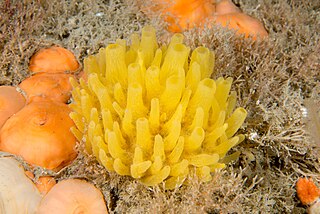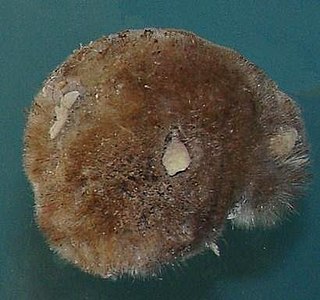
Hexactinellid sponges are sponges with a skeleton made of four- and/or six-pointed siliceous spicules, often referred to as glass sponges. They are usually classified along with other sponges in the phylum Porifera, but some researchers consider them sufficiently distinct to deserve their own phylum, Symplasma. Some experts believe glass sponges are the longest-lived animals on earth; these scientists tentatively estimate a maximum age of up to 15,000 years.

Polymastia is a genus of sea sponges containing about 30 species. These are small to large encrusting or dome-shaped sponges with a smooth surface having many teat-shaped projections (papillae). In areas of strong wave action, this genus does not grow the teat structures, but instead grows in a corrugated form.

Polymastiidae is a family of demosponges found in oceans throughout the world. It is the only family in the monotypic order Polymastiida. A useful diagnostic characteristic of members of this family is the presence of numerous surface papillae although this feature is shown by some other sponges.
Acanthopolymastia is a small genus of demosponges belonging to the family Polymastiidae. It has three describe species. These small, bristly, cushion-shaped sponges are only known from deep-sea sites in the southern oceans.
Polymastia fusca is a species of sea sponge belonging to the family Polymastiidae. It is found in shallow subtidal habitats in the far north of North Island, New Zealand.
Proteleia tapetum is a species of sea sponge belonging to the family Polymastiidae. It is found in shallow subtidal and intertidal habitats in the far north of North Island, New Zealand.
Polymastia lorum is a species of sea sponge belonging to the family Polymastiidae. It is only known from a single specimen found attached to a dead Glycimeris valve on a reef near Ohinau Island, one of the Mercury Islands off North Island, New Zealand.
Polymastia echinus is a species of sea sponge belonging to the family Polymastiidae. It is only known from shallow subtidal habitats off Te Hāwere-a-Maki / Goat Island in the north of the North Island of New Zealand.
Polymastia crocea is a species of sea sponge belonging to the family Polymastiidae. It is found in subtidal habitats below 6 m depth in the far north of the North Island of New Zealand.
Polymastia umbraculum is a species of sea sponge belonging to the family Polymastiidae. It is only known from rocky subtidal habitats around Kawau Island off the North Island of New Zealand.
Polymastia rubens is a species of sea sponge belonging to the family Polymastiidae. It is only known from rocky subtidal habitats around Kawau Island off North Island, New Zealand.
Polymastia aurantia is a species of sea sponge belonging to the family Polymastiidae. It is found in intertidal habitats including tide pools in the vicinity of Auckland, New Zealand.
Polymastia pepo is a species of sea sponge belonging to the family Polymastiidae. It is a common species of rocky subtidal and intertidal habitats in the far north of North Island, New Zealand.
Polymastia hirsuta is a species of sea sponge belonging to the family Polymastiidae. It is found in various subtidal habitats in the far north of North Island, New Zealand.
Acanthopolymastia acanthoxa is a species of sea sponge belonging to the family Polymastiidae. It is a deep-ocean species found on muddy substrates at depths of over 3000 m in the Ross Sea, Antarctica.
Acanthopolymastia bathamae is a species of sea sponge belonging to the family Polymastiidae. It is only known from the Papanui Submarine Canyon off Dunedin, South Island, New Zealand.

Halichondria panicea, commonly known as the breadcrumb sponge, is a species of sea sponge belonging to the family Halichondriidae. This is an abundant sponge of coastal areas of the North Atlantic and the Mediterranean Sea ranging from the intertidal zone to a recorded depth of over 550 m. It is also found in the intertidal zone of the coast of the northern part of the North Island of New Zealand. It is very tolerant of a wide range of coastal habitats, including strong currents, high salinity and exposure to powerful wave action. Its only requirement is a rocky substrate which can include small cobbles.
Atergia is a genus of sponges belonging to the family Polymastiidae.
Polymastia penicillus is a species of sponge belonging to the family Polymastiidae. It is found in shallow water in the northeastern and the northwestern Atlantic Ocean, growing on rocks in areas of high sedimentation.

Parininihi Marine Reserve is a marine reserve administered by the Department of Conservation, covering 1,800 hectares in the North Taranaki Bight. It is located offshore of the west coast of New Zealand's North Island, north-east of New Plymouth.




